George Vincent (painter)
| George Vincent | |
|---|---|
 John Jackson's portrait of Vincent (National Portrait Gallery, London) | |
| Born |
June 27 1796 Norwich |
| Died |
probably 1832 possibly Bath, Somerset |
| Residence | Norwich, London |
| Nationality | English |
| Education | Norwich School; trained by John Crome (1768–1821) |
| Known for | landscape painting |
| Notable work | View of Greenwich Hospital |
| Movement | Norwich School of painters |
George Vincent (27 June 1796 – c.1832) was an English landscape painter. He is considered to be one of principal artists of the Norwich School of painters, with his work founded on the style of the Norwich artist John Crome and of Dutch landscape painting.
Vincent was the son of a Norwich weaver. He was educated at Norwich School and apprenticed to Crome. He exhibited at the Norwich Society of Artists each year from 1811 until 1831, showing a total of more than one hundred pictures, mostly of Norfolk landscapes, rural scenes and marine works. He also exhibited at the Royal Academy, the British Institution, and elsewhere. By 1818 he had relocated to London and was initially successful in obtaining the patronage of a number of wealthy clients, but he then began to struggle financially. The purchase of a house in London that proved expensive to maintain, along with a tendency to drink, exacerbated his problems, and in 1824 he was incarcerated in the Fleet Prison for debt. Before being released from prison in 1827 he resumed his connection with the Norwich Society of Artists, all be it with a much declined output of work.
Little is known of the last few years of George Vincent's life. He is known to have contributed to an art exhibition in Norwich in 1831, but his whereabouts after this date remain uncertain. There is evidence that he died before April 1832, probably in Bath. Two exhibitions in London of Vincent's picture Greenwich Hospital from the River (1827), held thirty years after his death, caused an increased interest in his paintings and established his reputation as a leading member of the Norwich School, as well as the realisation that had he lived, Vincent could have been one of Britain's great landscape painters.
Life
Boyhood
Little is known of Vincent's early childhood, which was similar to that of his close friend James Stark. He was born in the Norwich parish of St John Timberhill on 27 June 1796,[1] the son of a weaver, James Vincent, who manufactured shawls, and his first wife Mary (born Mary Freeman).[2] In 1794 a son, also called George, had previously died in infancy.[3] The family are known to have lived at one time in St. Clement's Church Alley, close to the River Wensum in the centre of the city. George's mother died in about 1800, when he was a small boy.
George Vincent was the first cousin (on his mother's side) of Sir William Jackson Hooker, a renowned botanical illustrator who became the Director of the Royal Botanic Gardens, Kew in 1841.[4]
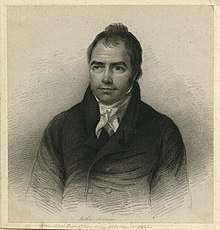
Vincent evidently enjoyed drawing with charcoal during his childhood.[5] He was educated at Norwich School, where he became good friends with the young sons of the artist John Crome, Frederick and John Berney Crome,[6] and with James Stark, whose father was a dyer and who would have known George Vincent's father through his business connections.[7]
Early adulthood
On leaving school he was apprenticed to Crome, perhaps as early as 1812,[8] along with fellow pupils John Berney Crome and James Stark. The three friends, of whom Vincent was the most talented,[5] travelled together on sketching and painting trips, influencing each other's artistic styles in the process.[9] In 1816 Vincent travelled to Paris along with John Berney Crome and a surgeon named Benjamin Steel, who was to marry John Berney's sister Hannah six years later.[note 1] In a letter written by John Crome, Vincent was reported to be seasick during the crossing. His View of Rouen was probably painted as a result of the journey through France. He then toured Essex, resulting in works depicting Ingatestone and Little Baddow.[7] In around 1818 he left Norwich and moved to London, living first at 7 Wells Street,[8] and then at 86 Newman Street, where he lived until 1821.[11][note 2]
He travelled from London to be present at John Crome's funeral in 1821, although by April that year he was in "very indifferent health".[13]
Marriage and subsequent decline
.jpg)
On 3 November 1821 Vincent married nineteen-year-old Mary Elizabeth Cugnoni, the only daughter of the surgeon James Cugnoni, who was, according to James Stark, extremely wealthy.[8][14] The event was recorded in the Norfolk Chronicle a week later.[15] No children are known to have been produced from the marriage. He bought a "good house" in Camden Town (referred to by some sources, e.g. in Painters and their Works (1896), as in Kentish Town),[16] which was subsequently sold when his wife's money failed to materialise and he was unable to generate enough income from his paintings. By the summer of 1824 Vincent and his wife had moved and were living at 26 Upper Thornhaugh Street, close to Bedford Square, which was more affordable and in a more centralised location.[7][note 3]
His health deteriorated and his debts mounted, in part because of his drinking habits.[5][20] A letter from George Vincent to his Norwich friend William Davey referred briefly to an unexplained "past folly", which seems to have been the cause of a permanent rift between Vincent and James Stark, as well as with his father, already troubled by his intemperance.[21] In another letter written in October that year to Davey, Vincent mentions: "To me it has been — and likewise to my better half — a great source of pleasure to wander over the scenes of former days", with the implication that he was still happily married at this time.[22]
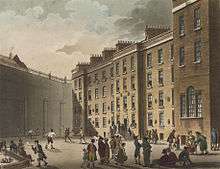
Both Vincent's alcoholism and the rumours about the 'past folly' exasperated his debt problems. He was committed to London's Fleet Prison in December 1824, where he was forced to remain until his release on 13 February 1827.[5][23] With the help of his father-in-law and his friends he was able to exhibit five paintings,[5] and was permitted to travel back to Norwich in the company of a prison keeper, most probably so as to raise funds from the sale of his paintings, or to acquire money by some other means. He revealed the embarrassment he felt upon being incarcerated in a debtor's prison in a letter to Davey written in December 1824, requesting, "As it will be necessary to name it to J.S., beg of him not to notice my residence to a soul; and, above all, do not name it to my father, as it would make the poor old man very miserable".[note 4][22]
Disappearance from public view
After 1831, Vincent disappeared from public view, and was not heard from or seen by his friends again, despite attempts by his family to locate him. Sir Joseph Dalton Hooker, writing in his father's biography, stated that "George Vincent was well educated and brought up, but lost himself. My father, his cousin, vainly endeavoured to trace his end in London".[4] In the catalogue of his pictures shown by the Society of British Artists in 1832, he was described as "deceased", but uncertainty surrounds both the date and cause of his death. He may have died at some time before 14 April 1832, when a notice appeared in the Norwich Mercury: "Died lately at Bath, in his 36th year, Mr George Vincent, artist, son of Mr. James Vincent, of this city".[24][2] R. H. Mottram, who described Vincent's appearance from his portraits as that of a boy who was too sensitive to withstand a life of sea travel or heaving drinking, described Vincent's death as "completely mysterious". He suggested that Vincent's wish to avoid creditors was a possible reason for his disappearance.[25]
In contrast with the single newspaper report of his death in 1832, the author of an article on Vincent in the Dictionary of National Biography, 1885-1900 believed that following his father's death in April 1833, he travelled to Norwich to attend the funeral, that being the last occasion in which he was seen by his family, and that he received a sum from the will.[5] However, as the belongings of Vincent's house in London were sold by auction in January 1833,[26] and on 2 May 1833, his widow re-married, marrying a journalist named Thomas Murphy at St Pancras Old Church,[27] the Dictionary of National Biographys suggestion that he died after 1833 is unlikely to be correct.
Artistic career
%2C_with_landscape_background_by_himself'.jpg)
George Vincent is considered to be one of principal artists of the Norwich School: his work was founded on the style of his master, John Crome, and of landscapes of the Dutch Golden Age of paintings.[28]
As a youth, he contributed elementary works to the exhibitions in Norwich at Sir Benjamin Wrench's Court, in 1811 and 1812,[29] his pictures being described as "after Crome".[2] He exhibited there with the Norwich Society of Artists every year from 1811 until 1831, showing a total of 106 pictures, which included seventy-five landscapes, six seascapes and sixteen architectural works.[30] In 1814 he exhibited a view of a Norfolk scene at the Royal Academy and another in 1815 at the British Institution, but he was not a regular exhibitor in London until he relocated from Norfolk to the capital. In London he at first received a fair amount of patronage and painted some pictures of importance. In 1817, together with James Stark, he enrolled as a student at the British Institute's school, but after two years Stark was forced to return home to Norwich due to ill health.[7]
Vincent exhibited a total of nine works at the Royal Academy, forty-one at the British Institution (yearly from 1815 to 1831, except 1816 and 1828), and twelve in Suffolk Street. His pictures were mostly views of the Norfolk countryside, but also of Scottish scenes and of boats, and in 1816 he and James Stark both exhibited views of Windsor after touring the area together.[7] In 1819 he embarked on his first tour of Scotland, which resulted in paintings such as View of Edinburgh from Calton Hill and Fishing Boats on the Bank of the Forth - evidence, according to Harold Day, that he was at the height of his powers during this period.[7] The following year he exhibited London from the Surrey Side of Waterloo Bridge at the gallery of the Old Watercolour Society, which was opened to non-members on that occasion. The picture was bought by Lord De Tabley. In the same year he exhibited View of Greenwich from Blackwall at the British Institution.[5]
In 1824 he started to prepare two pictures, of the Battle of the Nile and the Battle of Trafalgar, to compete for a prize offered by the directors of the British Gallery.[5] Although living in London, he still saw himself as a Norfolk man, writing of Nelson, "The Norfolk hero gained those battles, and shall it be said that Norfolk artists would not contend for the prize now offered?"[2] Neither work was completed, because of his imprisonment in the Fleet Prison.[5] In 1825, when he was permitted to travel from prison to visit James Stark at Norwich, he attempted to resume his connection with the Norwich Society and sent five works to their exhibition. A year after his release in February 1827, he sent six pictures to the Norwich exhibition, and in 1831 he exhibited his last picture there.[5]
Vincent produced a number of etchings from his own drawings and paintings, including those now held at the British Museum. These date from 1821 to 1827, but earlier works were made before he left Norwich for a career in London.[5]
Influences, reputation and legacy

The influence of Crome's paintings such as A Fishmarket at Boulogne (1820) can be seen in George Vincent's work,[31] and works by Vincent have in the past been attributed to Crome, but he lived away from his master's home city of Norwich for most of his working life, and his work is more easily compared with the paintings of John Constable and J. M. W. Turner, both of who were working in London at the time. The art historian Andrew Moore regards Vincent as one of the most talented British artists of the 1820s.[8]
Vincent has been confused with Crome’s son, John Berney Crome: A View of Yarmouth from Gorleston was once reputed to being by John Berney Crome when it was sold, but it was afterwards found to be by Vincent, when a boat depicted in the picture was shown to have his initials on the side.[32] Vincent approaches Crome's naturalism, but is notably inferior with regard to sense of composition.[33]
According to the art historian Herbert Minton Cundall (1848-1940), Vincent's paintings were more atmospheric that those produced by his contemporary James Stark, and he was the finer painter. Cundall believed of Vincent that "if he had not given way to intemperate habits he would probably have ranked amongst the foremost of British landscape painters."[2] In 1831 the Norwich Mercury described Stark as being John Crome's closest follower, viewing Vincent instead as the artist who continued his principles, but ;ater commentators have disagreed.[34] James' A Dictionary of Artists, written in 1896, ranked Vincent behind Crome, Cotman and James Stark, but noted that £740, the price paid for his oil painting Greenwich Hospital in 1888 (£50,000 in modern terms),[35] was far more than that paid for any Crome work at that time.[16]
His paintings can can sell for high prices, with Ship Building at Greenwich (c. 1823) sellings at Bonhams in 2011 for £27,500.[36]
Trowse Meadows, near Norwich was used by Hyperion Records on their 1980 cover of the Stanford and Finzi clarinet concertos, featuring Thea King and the Philharmonia Orchestra.[37]
In 2018 it was announced that a catalogue raisonné by Alastair Tort is in the process of being produced.[38]
Selected paintings
Greenwich Hospital from the River (1827)
George Vincent's talents as a landscape painter went largely unrecognised outside Norwich until 1862, when his View of Greenwich Hospital (1827) was shown at the International Exhibition.[5][2] This large picture helped to secure his reputation as a great landscape painter.[39][40] Richard and Samuel Redgrave, writing in the Landmarks in Art History series (in 1890), described his "noble" and "thoroughly executed" painting as indicative of what Vincent was capable of producing when at the height of his powers, it being a work which would have made him one of the great landscape artists of his time, had he gone on to produce paintings of a similar quality.[29] According to William Dickes, Greenwich Hospital from the River was Vincent's masterpiece.[41]
The painting was originally commissioned for a Mr Carpenter as a result of the action of Vincent's friend James Wadmore, and would have provided a much-needed source of income for Vincent. It was possibly the painting lent by Wadmore to the Society of British Artists and exhibited in 1834, and which was in his possession when he lent it to the 1862 International Exhibition. It was sold in 1866 (after Wadmore's death) to a Mr Fordham of Stourton Castle, and then passed to William Orme Foster (1814–1899),[5] being lent by Foster for an exhibition in 1877, which helped increase Vincent's reputation still further.[42] A Spectator article of that year described the work as "a fine, vigorous painting, the drawing and grouping of the boats being first-rate, and the sky also exceptionally good".[43] A detailed description of the painting can be found in Dickes' The Norwich school of painting.[41]
Other paintings
A portrait of Vincent by Clover was bequeathed to the Norwich Castle Museum in 1899 by J. J. Colman, along with Trowse Meadows. Colman also owned one of Vincent's best pictures, On the Yare. His masterpiece, Greenwich Hospital established Vincent's reputation as a watercolourist when it was exhibited in 1862 and again in 1877, when it was shown at the Winter Exhibition at Burlington House.[5]
Paintings by Vincent are held in museums and galleries around the UK. Middle Mill, Wandsworth is part of the British Government's Art Collection and is on display at the British Embassy in Luxembourg.[44]
- Portrait of George Vincent (1796-1832), with landscape background by himself (undated) Norwich Museums Collections
- A Shady country road (undated) Norwich Museums Collections
- Scene on the River Yare (undated drawing) British Museum
- Landscape, Cattle Crossing a Stream (undated) Norwich Museums Collections (ArtUK)
- Postwick Grove, Norwich (undated) Norwich Museums Collections (ArtUK)
- A Distant View of Pevensey Bay, the Landing Place of King William the Conqueror (c.1817) Norwich Museums Collections (ArtUK)
- A View of Cheddar Gorge (c.1820) Yale Center for British Art
- Dutch Fair on Yarmouth Beach, Norfolk (1821) Norwich Museums Collections (ArtUK)
- A Distant View of Pevensey Bay, the Landing Place of King William the Conqueror (1824) Norwich Museums Collections (ArtUK)
- Highlanders Spearing Salmon (exhibited 1825)
- The Travelling Pedlar (c.1826) Norwich Museums Collections (ArtUK)
- Greenwich Hospital from the River (1827)
- Fish Auction, Yarmouth Beach, Norfolk (1828) Norwich Museums Collections (ArtUK)
- Landscape (c.1828) Victoria & Albert Museum
- Trowse Meadows, near Norwich (painting) (1828) Norwich Museums Collections
- The Needles (1830) Norwich Museums Collections
- The Blasted Oak (1830) Norwich Museums Collections
Gallery
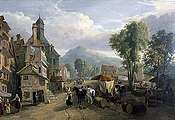 Rouen (undated), Norfolk Museums Collections
Rouen (undated), Norfolk Museums Collections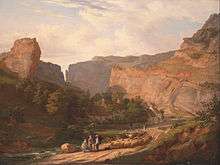 A View of Cheddar Gorge (c. 1820), Yale Center for British Art
A View of Cheddar Gorge (c. 1820), Yale Center for British Art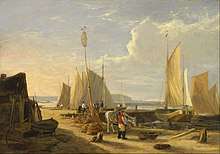 A Harbour Scene in the Isle of Wight, Looking Towards the Needles (1824), Yale Center for British Art
A Harbour Scene in the Isle of Wight, Looking Towards the Needles (1824), Yale Center for British Art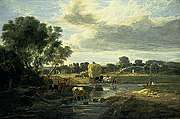 Trowse Meadows, near Norwich (undated), Norfolk Museums Collections.[45]
Trowse Meadows, near Norwich (undated), Norfolk Museums Collections.[45]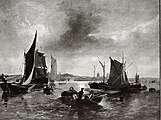 Greenwich Hospital (1827), a work produced the year Vincent was released from the Fleet.
Greenwich Hospital (1827), a work produced the year Vincent was released from the Fleet.
Notes
- ↑ Parish records show that Benjamin Steel married John Crome's youngest daughter Hannah on 27 June 1822, at St George's Church, Colegate, Norwich.[10]
- ↑ Vincent lived next door to James Stark whilst at Newman Street, where nearly every house was occupied by working artists and a residence there was regarded as a “step on the road to fame”. By the 1880s, although artists had lived there throughout much of the nineteenth century, Newman Street had lost its previous glamour.[12]
- ↑ Upper Thornaugh Street parallel to Tottenham Court Road and north of Bedford Square, was renamed Huntley Street in the 1830s. The street appeared on London maps of the period labelled with either name.[17] All the streets where Vincent lived can be found using Christopher Greenwood's[18] and George Cruchley's[19] 1827 maps of London.
- ↑ Part of the letter written from Vincent to his friend in Norwich reads: "I shall experience very great inconvenience from being shut up in this miserable place. I can paint small pictures here but not any of size, but this is not the only evil. Being excluded from the world I shall find it no small difficulty to dispose of my works when painted, and, should I reserve them for the Exhibition, in all probability the money may not be forthcoming until after the close. Having two small pictures finished, intended for the British Gallery, the one 36 x 25, A View in Glen Skerrah, near Inverary, and the second 17 x 14, Boats Making for Home at the approaching Storm. If there are any of your friends who would like to have them at a very low price I need not say how much it would benefit me upon the present occasion. For No. 1, I would be glad to take £15, for No. 2, ,£8, being half the price I should ask for them at the Gallery. As it will be necessary to name it to J. S. beg of him not to notice my residence to a soul; and, above all, do not name it to my father, as it would make the poor old man very miserable. Pray favour me with a line and direct as usual, as I should be sorry the people at the Post Office at Norwich should see any address to me here .... Hoping you and Mrs. Davey and the happy trio are quite well. I remain, Your Obedient Servant , No. 8 Third Gallery, The Fleet, George Vincent. Dec. 27, 1824".[22]
Footnotes
- ↑ Norwich Public Library Readers' Guide (1915), vols. 4-6, p.163.
- 1 2 3 4 5 6 Cundall, The Norwich School, p26-27.
- ↑ "England Births and Christenings, 1538-1975", FamilySearch (12 February 2018, George Vincent). Index based upon data collected by the Genealogical Society of Utah, Salt Lake City; FHL microfilm 1,526,854.
- 1 2 Hooker, A sketch of the life and labours of Sir William Jackson Hooker, p. x.
- 1 2 3 4 5 6 7 8 9 10 11 12 13 14

- ↑ Mottram, John Crome of Norwich, p.168.
- 1 2 3 4 5 6 Day, The Norwich School of Painters, p. 87.
- 1 2 3 4 Moore, The Norwich School of Artists, pp. 33-34.
- ↑ George Vincent at the Burlington dealership website.
- ↑ Family Search data for Benjamin Steel.
- ↑ Day, East Anglan Painters vol. II, p. 106.
- ↑ "Chapter 30: The Berners Estate: Berners and Newman Streets" (PDF). UCL. 2016-07-07. Retrieved 2018-10-04.
- ↑ Hemingway, The Norwich School of Painters 1803-1833, p.64.
- ↑ "England Marriages, 1538–1973", FamilySearch (10 February 2018), James Cugnoni in entry for George Vincent and Mary Elizabeth Cugnoni, 03 Nov 1821. Citing Middlesex, England, index based upon data collected by the Genealogical Society of Utah, Salt Lake City. FHL microfilm 413,266.
- ↑ "Norfolk Chronicle - Saturday 17 November 1821". The British Newspaper Archive. British Library. 2018. Retrieved 12 October 2018.
- 1 2 James, Painters and their Works, pp. 222-223.
- ↑ "Duke of Bedford's Estate". UCL Bloomsbury Project. 2011-04-14. Retrieved 2018-10-08.
- ↑ "Composite: Sheets 1-6. Map of London... August 21 1827". David Rumsey Map Collection. 2018. Retrieved 2018-10-08.
- ↑ "Cruchley's New Plan Of London 1827". Map and Plan Collection Online (MAPCO). 2018. Retrieved 2018-10-08.
- ↑ Mottram, John Crome of Norwich, p.184.
- ↑ Correspondence from Vincent to his friend William Davey are held in the British Library (Reference: Add MS 37030).
- 1 2 3 4 Day, The Norwich School of Painters, p. 91.
- ↑ "All London, England, King's Bench and Fleet Prison Discharge Books and Prisoner Lists, 1734-1862 results for George Vincent". Ancestry (subscription required). 2018. Retrieved 8 October 2018.
- ↑ Dodgson, Campbell, rev. Norma Watt (2004). "Vincent, George". Oxford Dictionary of National Biography. Oxford University Press. Retrieved 12 February 2015. (subscription required)
- ↑ John Crome of Norwich, pp.168-9.
- ↑ "Morning Advertiser - Thursday 31 January 1833". The British Newspaper Archive. British Library. 2018. Retrieved 7 October 2018.
Upwards of 700 Lots of Miscellaneous Property, the effects of the late George Vincent, Artist, deceased, comprising prints, drawings, sketches, books, paintings by eminent Masters, in a fine state of preservation, biscuit china groups, cabinet piano-forte, jewellery, linen, apparel, plate and plated good, fancy articles in rosewood, fur, snuffs and tippets, china, glass, watches, clocks, musical instruments, and other pledge stock, a few lots of household furniture, &c. &c. On view and Catalogues to be held at the Rooms.
- ↑ "England Marriages, 1538–1973", FamilySearch (10 February 2018), Thomas Murphy and Mary Elizabeth Vincent, 02 May 1833. Citing Old Church,Saint Pancras,London,England, index based upon data collected by the Genealogical Society of Utah, Salt Lake City; FHL microfilm 598,180, 598,181, 598,182, 598,183, 598,184, 598,185, 598,186.
- ↑ Cundall, The Norwich School, p.2.
- 1 2 Redgrave, A Century of British Painters, p.354.
- ↑ Rajnai, The Norwich Society of Artists, 1805-1833, p. 92, p. 144..
- ↑ Moore, The Norwich School of Artists, p. 25.
- ↑ Cundall, The Norwich School, p.6.
- ↑ Moore, The Norwich School of Artists, p. 21.
- ↑ Hemingway, The Norwich School of Painters 1803-1833, p.61.
- ↑ "Currency converter: 1270–2017". The National Archives. Retrieved 7 October 2018.
- ↑ "Lot 1 - George Vincent (British, 1796-1831) Ship building at Greenwich". Bonhams. Retrieved 7 October 2018.
- ↑ Patrick Rucker (14 July 2016). "Which is the best recording of Finzi's Clarinet Concerto?". Gramophone. MA Business and Leisure Ltd. Retrieved 13 October 2018.
- ↑ "Sale F120918 Lot 167 George Vincent (British, 1796-1831)". Cheffins. 2018. Retrieved 11 September 2018.
- ↑ Cundall, The Norwich School, p.3.
- ↑ Louis Viardot, An Illustrated History of Painters of All Schools. p.430.
- 1 2 Dickes, The Norwich school of painting, p. 506.
- ↑ 1877 - Old Masters and deceased masters of the British School, 1877, p. 5.
- ↑ "20 January 1877, Page 15: Art". The Spectator Archive. The Spectator (1828) Ltd. 2013. Retrieved 10 October 2018.
- ↑ "The Collection". Government Art Collection. Department for Digital, Culture, Media & Sport. Retrieved 7 October 2018.
- ↑ The painting is an example of a work originally framed by Vincent's contemporary, John Thirtle.
References
- Cundell, H.M. (1920). The Norwich School. London: Geoffrey Holme Ltd.
- Day, Harold (1979). The Norwich School of Painters. Eastbourne, UK: Eastbourne Fine Art. ISBN 0 902010 10 7.

- Dickes, William Frederick (1905). The Norwich school of painting: being a full account of the Norwich exhibitions, the lives of the painters, the lists of their respecitve exhibits and descriptions of the pictures. Norwich: Jarrold & Sons Ltd.
- Hemingway, Andrew (1979). The Norwich School of Painters, 1803-33. Oxford: Phaidon. ISBN 9780714820019.
- Hooker, Joseph Dalton (1902). "A Sketch of the Life and Labours of Sir William Jackson Hooker". Annals of Botany. 16 (4): 605.
- James, Ralph N. (1896). Painters and their works: a dictionary of great artists who are not now alive, giving their names, lives, and the prices paid for their works at auctions. London: L. U. Gill.
- Moore, Andrew W. (1985). The Norwich School of Artists. HMSO/Norwich Museums Service.
- Mottram, Ralph Hale (1931). John Crome of Norwich. London: John Lane The Bodley Head Ltd.
- Rajnai, Miklos; Stevens, Mary (1976). The Norwich Society of Artists, 1805-1833: a dictionary of contributors and their work. Norfolk Museums Service for the Paul Mellon Centre for Studies in British Art.
- Redgrave, Richard & Samuel (1981). A Century of British Painters. New York: Cornell University Press. ISBN 0 8014 9217 3.
- The Royal Academy (1877). 1877 - Old Masters and deceased masters of the British School, 1877. London: The Royal Academy.
- Temple, Philip; Thom, Colin; Saint, Andrew (2017). Survey of London: South-East Marylebone (volumes 51 and 52). Yale University Press. p. 15, 19, 20.
- Walpole, Josephine (1997). Art and Artists of the Norwich School. Woodbridge: Antique Collectors' Club Holme. ISBN 1 85149 261 5.
External links
| Wikimedia Commons has media related to George Vincent. |
| Wikisource has the text of the 1911 Encyclopædia Britannica article Vincent, George. |
- Works relating to George Vincent in the British Museum
- 129 auction results for works by George Vincent on ArtNet (October 2018)
- Works relating to George Vincent in the Norfolk Museums Collections
- 59 works by George Vincent from Art UK
- Works by George Vincent at the Victoria and Albert Museum
- 7 works by George Vincent in the Yale Center for British Art, New Haven, Connecticut